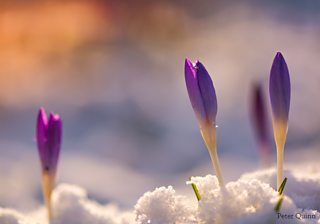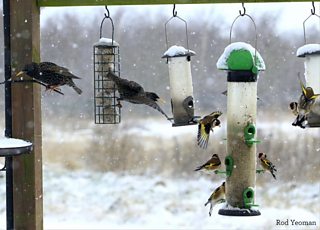It's March 1st, the first day of spring, we should by skipping through the snowdrop and daffodil filled woodlands and parklands smiling with the spring sunshine on our backs, but instead we've been lighting the fires, whacking the heating on full blast, digging out our hats, gloves and oddly mismatching scarves, panic buying and all for what? Well with temperatures as low as -11 in some areas of Scotland, the UK seems to be moving in a backwards weather motion. The beast from the east has arrived!

Though the earliest months of 2018 bought to us a stunning array of early spring flowers, including: lesser celandine, crocus, snow drops and daffodils, wildlife was also seen to be making the most of the mild conditions, with early frogs spawning, adders seen basking in January and some birds seen nest building. All the telltale signs for an early spring were looking encouraging and many of you been logging your early spring recordings via .
Now it's March, 3 months into the year and things have taken a dramatic twist - The beast from the east has rolled in and suddenly our picturesque spring landscapes have been thrown a thick white blanket of ice cold snow along with freezing arctic temperatures!
Panic mode has set in as hundreds of schools have closed across the country, transport has come to a standstill and the office emails for 'weather warning:leave early' are now circulating, and what's more, the forecast is not looking great for the next week ahead.

This cold snap of weather will inevitably affect our wildlife, impacting the availability of food and water for many species, as well as the effects of our early spring arrivals, including frogs spawn and early emerging insects and flowers. But fear not, there are many ways in which you can help your local wildlife out through this particularly cold snap. Here's how...
Food, glorious food!
All wildlife will be experiencing a shortage of food that is normally available to them, so you'll be helping them out enormously by putting out a selection of food for your birds including; sunflower hearts, oats, peanuts, mealworms and fat balls. If you have any left over high-fat foods, including cheese or pastry, then pop it out too as the birds will really benefit from the fats to help them keep warm.
Water source
Though sometimes we may be so fixed on providing our birds with food (which is extremely important), don't forget that the majority of water sources are likely to be frozen over. Remember to fill up a container of water close to your feeders, as our birds will also be extremely thirsty too. You can also provide water sources at ground level too- it's not all about the birds, many small and large mammals may rely on the water you provide. If you have a pond in your garden, you could place a ball into it and as the pond freezes a small unfrozen gap will be left around the ball, which will help provide oxygen to the water as well as entry in and out of the pond too.
Snowy sanctuary
These freezing conditions will make it difficult for many species to find shelter, so an upturned box filled with straw, or a log pile sheltered away under some trees or a hedge may rescue a wondering sole from the cold. We've even seen people attaching umbrellas to their bird feeders, to prevent the food from being encompassed by the cold snow and also to provide the birds with a little rest bite.

By doing your little bit to help wildlife in these arctic conditions, you will be throwing them a life line. Just like us, wildlife cannot survive without food or water, so lets not forget to make the special effort to brave the conditions ourselves for 5 minutes and watch nature thank us with the array of species that come to visit us.
